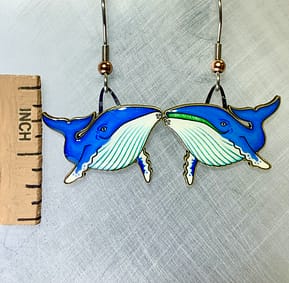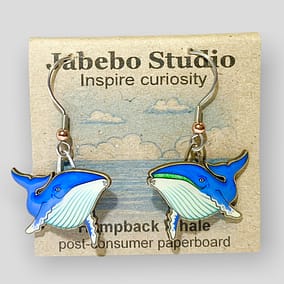
This whale can be found in all of the world’s oceans and is a favorite of whale-watchers. Topping out at up to 62 ft. and 40 tons, this whale can put on a dazzling show with breaches displaying its enormous pectoral fins.


After birthing and nursing calves in the warm waters of Mexico, this whale migrates northward to the cooler waters of Alaska in mid-February. From Alaska, they begin their journey back to Mexico in December. As bottom feeders, they can be seen by whale watchers near the coast.


The east coast population moves between feeding grounds along the New England coast and calving grounds just off Georgia and Northern Florida. These whales are likely to stay in shallower waters (for a whale) where they are more likely to encounter boat traffic. Their protection requires boats and ships to slow down in certain critical areas.


The killer whale can be found in every ocean around the globe. Social pods hunt cooperatively, which contributes to reputation as the ocean’s top predator. Females can live 90 years and, like a few select mammals, experience menopause.




Meet the world’s most abundant seal! Unlike other seals, they are solitary and, even when hauled out on shore or ice, maintain at least 3 ft. of distance between them. They are found in coastal waters of the Northern Hemisphere.




The sea otter is a keystone species in kelp beds and estuaries. If otters do not eat sea urchins, they will eat all of the kelp and create an area devoid of most life. When the otters eat crabs in estuaries, slugs flourish and eat damaging algae.


Seahorse design colors can be mixed and matched as desired.










Weighing up to 2.5 tons, it’s the largest bony fish out there! It gets to this size by eating a diet almost exclusively of jellyfish.


Their tail fin never grows, giving this fish an unusual shape. They are adept swimmers and can jump 10 ft. out of the water trying to remove skin parasites.




In Florida and the Caribbean this popular aquarium fish has escaped into the wild and is eating our native reef fish. They have voracious appetites and reducing the population of native fish that do not know how to avoid them. So far the only way we have to confront Lionfish is to go out and remove them. Luckily they make great seafood!


Love from the fish with the heart-shaped tailfin! These marine fishes are found only in reef and kelp beds from Baja California to Monterey Bay. Males select and tidy a nest site with hopes of attracting choosy females. Males fertilize and care for eggs.




Beautiful to observe in nature and yummy on the dinner table, the hogfish wins high marks in both categories. They are a common near shore fish of the Atlantic and Gulf coasts.




This beautiful reef dwelling fish is well known to South Florida and the Keys. Common and easy to spot, both divers and snorkelers can enjoy them.




It’s not as hard to say as you might think once you find the rhythm. The humuhumu (for short) is also known as the Reef Triggerfish and has a wide distribution through much of the tropical pacific. In Hawaii, where the humuhumu is celebrated in a classic song “My Little Grass Shack,” the humumuhumu the publicly elected State Fish.


These colorful fish are a common sight for divers and snorkels in southern Florida and through out the Caribbean. True for parrotfish in general, adults display two very different color morphs depending on whether it is in its initial (female) phase or the terminal (male). Typically, when a position in the social structure opens, one of the members of the initial phase population will transition to a terminal phase and assume a new role. For the Stoplight species the red individuals are usually female and the green are usually terminal males. Parrotfish help maintain reef health by eating algae growing on and smothering corals. Design by Kevin


A large robust denizen of coral reefs in southern Florida and the Caribbean. Encountering one is likely a high point for recreational snorkelers and divers. Although grouper are highly desired for food, in US waters Nassau grouper are protected in order to allow the population to recover after overfishing.


This fish is native to rivers and lakes west of the Rocky Mountains of North America but has been introduced throughout the globe as a tasty gamefish. Some will migrate from freshwater out to sea, staying for years as silvery stealheads before returning to spawn.


A native of northeastern states and Appalachia this species of trout relies on cool pristine mountain streams. Being a popular quarry for fly fishing, Brookies are the designated state fish in almost all the states in their native range. They have been introduced to areas in the west. Design by Cecil and Kevin


There are 5 species of Pacific Salmon in North America. All are powerful swimmers, migrating from open oceans to spawn in the same mountain stream where they began life.


Coelacanths were thought to be extinct until a live one was caught in 1938 and might be important for understanding the transition from water to land.




Baby Sharks are cute, but maybe you do not want to cuddle a baby White Shark, which can be born already weighing 77 lbs. Definitely do not mess with Mama Shark.








This herbivorous turtle is unique in its dependence on sea grasses and macro-algae for food. Like other sea turtles, the females come to beaches to lay their eggs.


Comparing various species of sea turtles, the nests of loggerheads are likely to be more numerous on beaches of Southeastern United States.


The most endangered of all the sea turtle species with a distribution centered in the Gulf of Mexico and along the Atlantic seaboard. Females synchronize their nesting so that most all come ashore at the same time and locations which was a dramatic sight when the nesting sea turtles numbered in the 10’s of 1000’s. This is an effort to assure some eggs will survive predation which worked until people starting taking larger quantities.














Though most of us know the semi-terrestrial pet store variety of hermit crabs, most of the ~800 species of hermit crabs are oceanic. Unlike the “true crabs”, hermit crabs cannot make their own shells and use shells abandoned by other animals.




Octopuses are very intelligent and have amazing adaptations. With pigment cells call chromatophores, they are able to change their skin color at-will to camouflage themselves or to warn predators.
